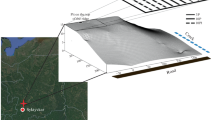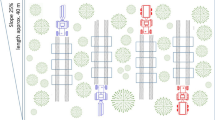Abstract
Mechanized harvesting procedures for typical forest vehicles were analysed to examine soil stresses and displacements occurring in soil profiles and to reveal changes in physical properties of forest soils. All field experiments were carried out under traffic lanes of standard forest vehicles in forest stands of the southern Black Forest. The soil stresses were determined using stress state transducers (SST) and displacement transducer systems (DTS) at depths of 20 and 40 cm. Complete harvesting and trunk-logging processes with a total time span of 9 min were observed. The maximum vertical stresses for all experiments exceeded 200 kPa; some experiments showed maximum vertical stresses up to 500 kPa or more at a depth of 20 cm. To evaluate the impact of soil stresses on soil structure, the internal soil strength was determined by predicting the precompression stress. Comparison of soil stress data with the natural bearing capacity of the natural forest soil proves that sustainable traffic is not possible, irrespective of the vehicle type and the working process. Topsoil and subsoil compaction, an increase in the precompression stresses, deep rutting and vertical as well as horizontal soil displacement associated with shearing effects took place and affected the mechanical strength and the physical properties of forest soils. Considering these results, heavy forest machinery has a severe impact on soil physical properties such as air, heat, water fluxes and rootability. In order to sustain the present undamaged soil condition, a change in harvest logistics and organisation is necessary. This can be achieved with a permanent skid-trail system which has already been designed to implement new guidelines in Baden-Württemberg, Germany (Ministerium für Ernährung und ländlichen Raum, Baden-Württemberg 2003, p 27).








Similar content being viewed by others
References
Boden AG (1994) Bodenkundliche Kartieranleitung, 4th edn. Schweizerbart’sche Verlagsbuchhandlung, Hannover, p 392
Alakukku L (2000) Response of annual crops to subsoil compaction in a field experiment on clay soil lasting 17 years. In: Horn R, van den Akker JJH, Arvidsson J (eds) Subsoil compaction: distribution, processes and consequences, vol 32. Advances in Geoecology. Catena Verlag, Reiskirchen, pp 205–208
Berli M, Kulli B, Attinger W, Schulin R (2000) Subsoil compaction of agricultural land by heavy construction machinery—soil mechanical aspects. In: Horn R, van den Akker JJH, Arvidsson J (eds) Subsoil compaction: distribution, processes and consequences, vol 32. Advances in Geoecology. Catena Verlag, Reiskirchen, p 462
Boizard H, Richard G, Brancourt-Hulmel M, Guérif J (2000) Effect of cropping systems on change in bulk desity, penetration resistance and hydraulic conductivity in subsoil. In: Subsoil compaction: distribution, processes and consequences, vol 32. Advances in Geoecology, Catena Verlag, Reiskirchen, pp 233–241
Casagrande (1936) Characteristics of cohesive soils affecting the stability of slopes and earth fill. J Boston Soc Civil Eng 23:13–22
Ehlers W, Werner D, Mähner T (2000) Wirkung mechanischer Belastung auf Gefüge und Ertragsleistung einer Löss Parabraunerde mit zwei Bearbeitungssystemen. Z Pflanzenernähr Bodenk 160:157–164
Froehlich HA, Miles DWR, Robbins RW (1985) Soil bulk density, recovery on compacted skid trails in central idaho. Soil Sci Soc Am J 4:1015–1017
Gaertig T (2001) Bodengashaushalt, Feinwurzeln und Vitalität von Eichen. Freib Bodenk Abh 40:157
Görbing J (1948) Die Grundlage der Gare im praktischen Ackerbau, vol 1 and 2. Landbauverlag, München
Gräsle W (1999) Numerische Simulation mechanischer, hydraulischer und gekoppelter Prozesse in Böden unter Verwendung der Finite Elemente Methode. Schriftenr Inst Pflanzenernähr Bodenk Univ Kiel 48:400
Gröger E (1921) Der Dampfpflug und seine wirtschaftliche und soziale Bedeutung unter Berücksichtigung des Lohnpflugbetriebes in Schlesien. Greifswalder Staatswissensch Abh, p 9
Gysi M (2001) Bodenverdichtung: Vorbelastung als Stabilitätsmaß. FAT Ber 566:1–7
Hakansson I (1994) Subsoil compaction caused by heavy vehicles—a long-term threat to soil productivity. Soil Till Res 29:105–110
Harris WL (1960) Dynamic stress transducers and the use of continuum mechanics in the study of various soil stress—strain relationships. PhD Thesis, Michigan State University, Ann Arbor
Hartge KH, Horn R (1999) Einführung in die Bodenphysik. Enke Verlag, Stuttgart
Heinonen M, Alakukku L, Aura E (2002) Effects of reduced tillage and light tractor traffic on the growth and yield of oats (Avena sativa), vol 35. Advances in Geoecology. Catena Verlag, Reiskirchen, pp 367–378
Horn R (2004) Time dependence of soil mechanical properties and pore functions for arable soils. Soil Sci Soc Am J 68:1131–1137
Horn R, van den Akker JJH, Arvidsson J (eds) (2000) Subsoil compaction: distribution, processes and consequences, vol 32. Advances in Geoecology. Catena Verlag, Reiskirchen, p 462
Horn R, Johnson CE, Semmel H, Schafer RL, Lebert M (1992) Räumliche Spannungsmessungen mit dem State Stress Transducer (SST) in ungesättigten aggregierten Böden—theoretische Betrachtung und erste Ergebnisse. Z Pflanzenernähr Bodenk 155:269–274
Johnson CE (1994) SSTKIEL.exe program for 3D-stress transducer data analysis for the soil. Version 8/94; unpublished data
Kühner S (1997) Simultane Messungen von Spannungen und Bodenbewegungen bei statistischer und dynamischer Belastung zur Abschätzung der dadurch induzierten Bodenbeanspruchung. Schriftenr Inst Pflanzenernähr Bodenk Univ Kiel, vol 39.
Ministerium für Ernährung und ländlichen Raum, Baden-Württemberg (eds) (2003) Richtlinie der Landesforstverwaltung Baden-Württemberg zur Feinerschließung von Waldbeständen. Stuttgart
Nichols TA, Bailey AC, Johnson CE, Grisso RD (1987) A stress state transducer for soil. Trans ASAE 30:1237–1241
Nissen B (1999) Vorhersage der mechanischen Belastbarkeit von repräsentativen Ackerböden der Bundesrepublik Deutschland—Bodenphysikalischer Ansatz. Schriftenreihe Institut für Pflanzenernährung und Bodenkunde der Universität Kiel, vol 50, Band
Pagliai M, Jones R (eds) (2002) Sustainable land management—environmental protection: a soil physical approach, vol 35. Catena, Special Issue of Advances in Geoecology, p 588
Rieppo K (2001) Forwarder werden immer schwerer. Forst und Technik 2:16–17
Schack-Kirchner H (1994) Struktur und Gashaushalt von Waldböden. Berichte Forschungszentrum Waldökosysteme Univ. Göttingen, Reihe A 112:145
Schäffer J, Hartmann R, Wilpert Kv (2001) Effects of timber harvesting with tracked harvesters on physical soil properties. In: Johansson J (ed) Proceedings from the third (final) meeting of a Concerted Action: excavators and Backhoe Loaders as Base Machines in Forest Operations; Pisa, Italy, 20 September 2000 to 22 September 2000. SLU, Uppsala, Research Note No. 11, pp 119–124
Sommer C (1998) Ein Konzept zur Vorbeugung von Bodenschadverdichtungen in der pflanzenbaulichen Produktion. Bodenschutz I, vol 3, Jahrgang, pp 12–16
Taylor HM, Brar GS (1991) Effect of soil compaction on root development. Soil Tillage Res 19:111–119
Webb RH, Steiger JW, Wilshire HG (1986) Recovery of compacted soils in Mojave Desert Ghost Towns. Soil Sci Soc Am J 50:1341–1344
Wehner T (2001) Technikkonzepte und ihre Auswirkungen auf den Boden. Schriftenreihe Freiburger Forstliche Forschung, Band 18:97–107
Weisskopf P, Gysi M (2002) Effects of heavy harvesting machines on soil structure. Adv GeoEcol 35:415–428
Werner D, Werner B, Herzau M (1998) The effects of mechanical stress and regenerative soil processes on the structure of conventionally and conservationally tilled loess soil—soil physical and image analytical findings. In: Advances in sugar beet research, vol 1. Soil compaction and compression in relation to sugar beet production, pp 21–34
Wiermann C (1998) Auswirkung differenzierter Bodenbearbeitung auf die Bodenstabilität und das Regenerationsvermögen lößbürtiger Ackerstandorte. Schriftenreihe Institut für Pflanzenernährung und Bodenkunde der Universität Kiel, vol 45, Band
Wollny E (1898) Untersuchungen über den Einfluß der mechanischen Bearbeitung auf die Fruchtbarkeit des Bodens. Forschungen auf dem Gebiet der Agrikultur-Physik 20:231–290
WRB, ISSS-ISRIC-FAO (1998) World Reference Base for Soil Resources. - FAO, World Soil Resources Report No. 84, Rome
Acknowledgements
The authors would like to thank the Ministry of Research and Education of the Federal Republic of Germany (BMB+F) for the funding and the Forest Research Institute of Baden Würtemberg in Freiburg (FVA) for the logistics and cooperation.
Author information
Authors and Affiliations
Corresponding author
Rights and permissions
About this article
Cite this article
Vossbrink, J., Horn, R. Modern forestry vehicles and their impact on soil physical properties. Eur J Forest Res 123, 259–267 (2004). https://doi.org/10.1007/s10342-004-0040-8
Received:
Accepted:
Published:
Issue Date:
DOI: https://doi.org/10.1007/s10342-004-0040-8




